Software Development Life Cycle: Analysis, Risk & Feasibility Report
VerifiedAdded on 2022/07/06
|18
|4969
|84
Report
AI Summary
This report provides a detailed overview of the Software Development Life Cycle (SDLC), focusing on different models, including iterative and sequential approaches like the Waterfall and V-models. It describes the various phases of the SDLC, such as planning, requirements definition, system design, software development, testing, deployment, and maintenance. The report also explains how risk is managed within these models, covering risk assessment, calculation of inherent risk, and the importance of risk assessment reports. Furthermore, it emphasizes the significance of a feasibility study, detailing its purpose and how technical solutions can be compared. This document serves as a comprehensive guide to understanding the SDLC and its critical components in software engineering. Desklib is a platform where students can find similar assignments and study resources.
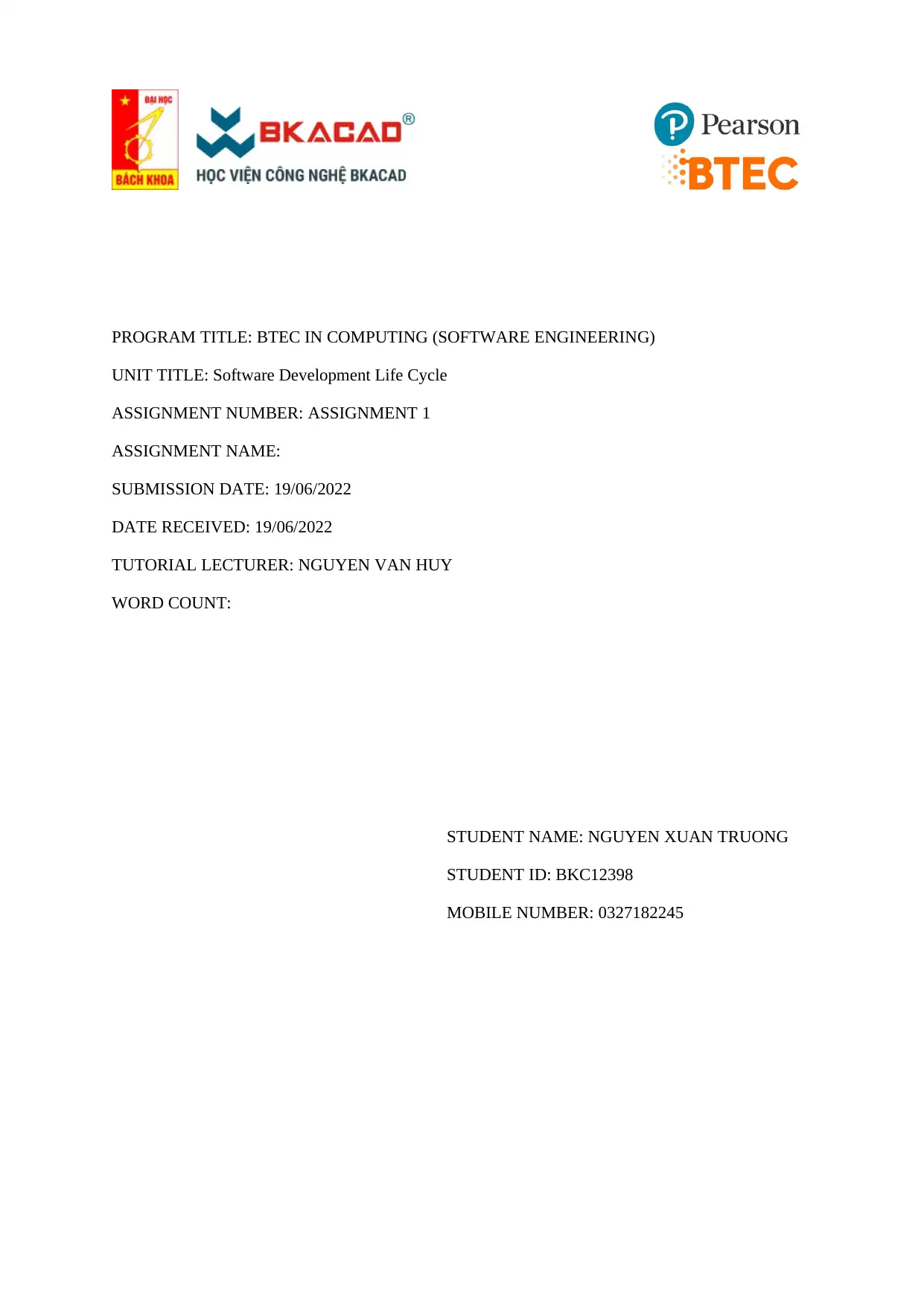
PROGRAM TITLE: BTEC IN COMPUTING (SOFTWARE ENGINEERING)
UNIT TITLE: Software Development Life Cycle
ASSIGNMENT NUMBER: ASSIGNMENT 1
ASSIGNMENT NAME:
SUBMISSION DATE: 19/06/2022
DATE RECEIVED: 19/06/2022
TUTORIAL LECTURER: NGUYEN VAN HUY
WORD COUNT:
STUDENT NAME: NGUYEN XUAN TRUONG
STUDENT ID: BKC12398
MOBILE NUMBER: 0327182245
UNIT TITLE: Software Development Life Cycle
ASSIGNMENT NUMBER: ASSIGNMENT 1
ASSIGNMENT NAME:
SUBMISSION DATE: 19/06/2022
DATE RECEIVED: 19/06/2022
TUTORIAL LECTURER: NGUYEN VAN HUY
WORD COUNT:
STUDENT NAME: NGUYEN XUAN TRUONG
STUDENT ID: BKC12398
MOBILE NUMBER: 0327182245
Paraphrase This Document
Need a fresh take? Get an instant paraphrase of this document with our AI Paraphraser
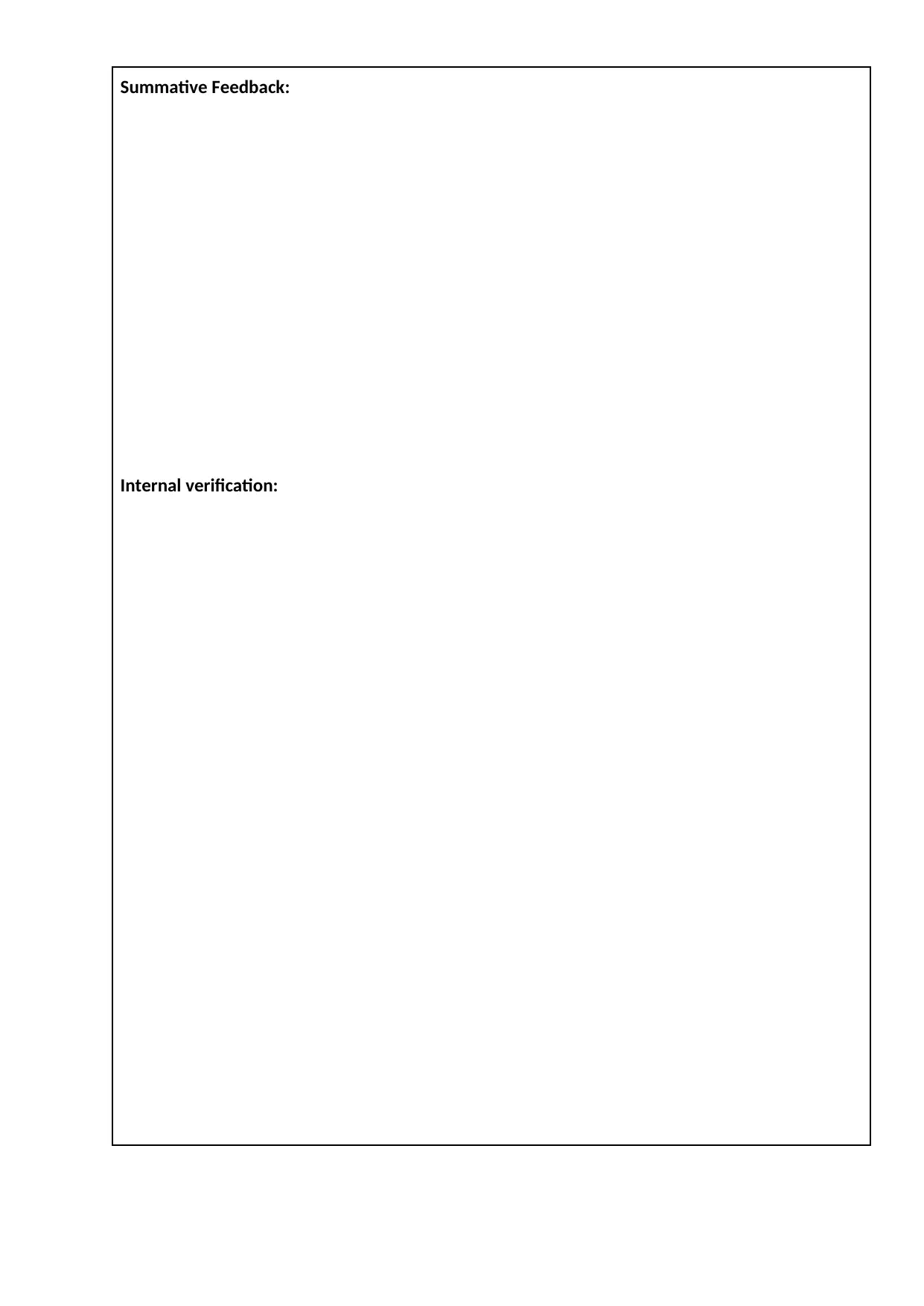
Summative Feedback:
Internal verification:
Internal verification:
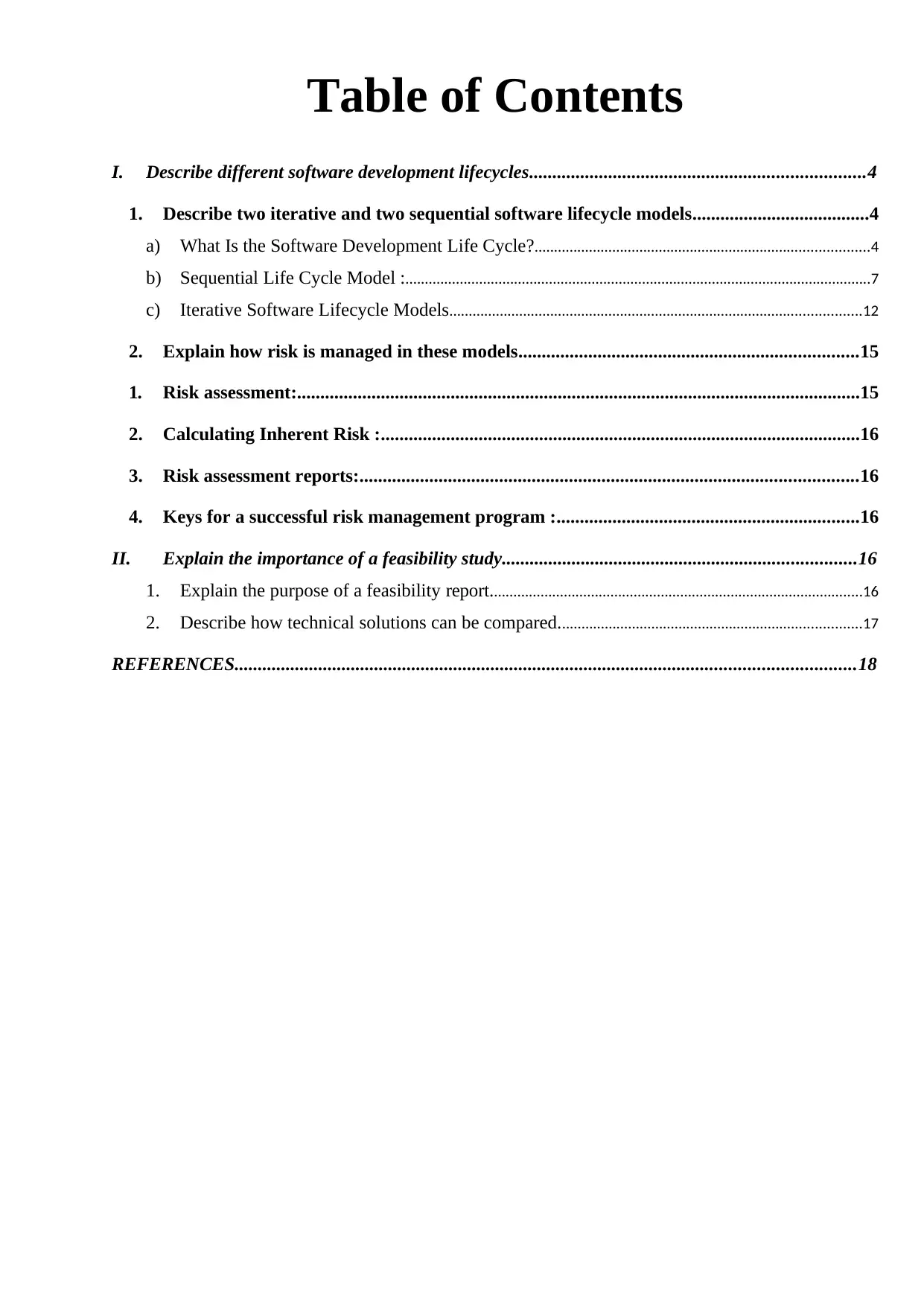
Table of Contents
I. Describe different software development lifecycles........................................................................4
1. Describe two iterative and two sequential software lifecycle models......................................4
a) What Is the Software Development Life Cycle?......................................................................................4
b) Sequential Life Cycle Model :........................................................................................................................7
c) Iterative Software Lifecycle Models..........................................................................................................12
2. Explain how risk is managed in these models.........................................................................15
1. Risk assessment:.........................................................................................................................15
2. Calculating Inherent Risk :.......................................................................................................16
3. Risk assessment reports:...........................................................................................................16
4. Keys for a successful risk management program :.................................................................16
II. Explain the importance of a feasibility study............................................................................16
1. Explain the purpose of a feasibility report................................................................................................16
2. Describe how technical solutions can be compared..............................................................................17
REFERENCES.....................................................................................................................................18
I. Describe different software development lifecycles........................................................................4
1. Describe two iterative and two sequential software lifecycle models......................................4
a) What Is the Software Development Life Cycle?......................................................................................4
b) Sequential Life Cycle Model :........................................................................................................................7
c) Iterative Software Lifecycle Models..........................................................................................................12
2. Explain how risk is managed in these models.........................................................................15
1. Risk assessment:.........................................................................................................................15
2. Calculating Inherent Risk :.......................................................................................................16
3. Risk assessment reports:...........................................................................................................16
4. Keys for a successful risk management program :.................................................................16
II. Explain the importance of a feasibility study............................................................................16
1. Explain the purpose of a feasibility report................................................................................................16
2. Describe how technical solutions can be compared..............................................................................17
REFERENCES.....................................................................................................................................18
⊘ This is a preview!⊘
Do you want full access?
Subscribe today to unlock all pages.

Trusted by 1+ million students worldwide
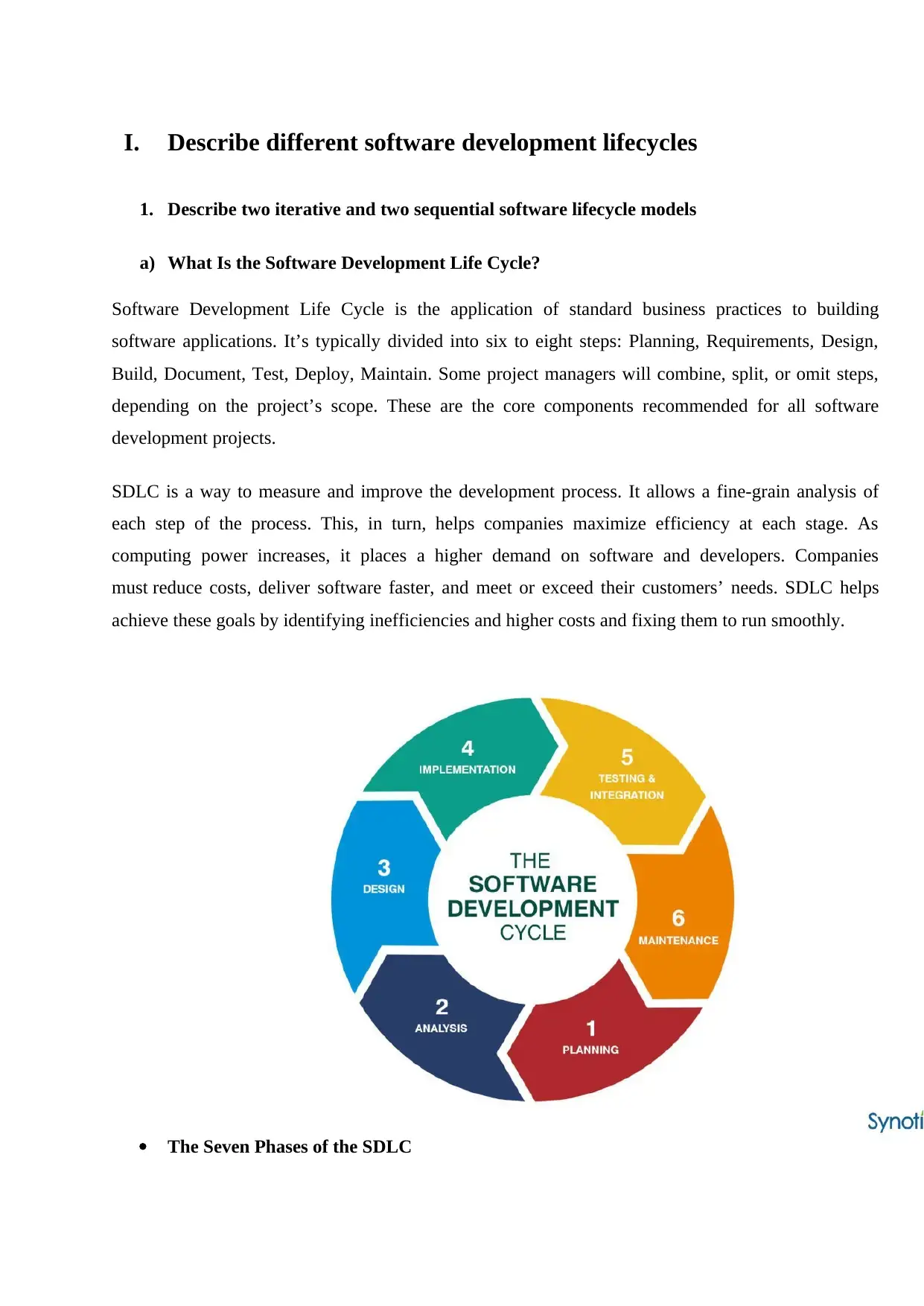
I. Describe different software development lifecycles
1. Describe two iterative and two sequential software lifecycle models
a) What Is the Software Development Life Cycle?
Software Development Life Cycle is the application of standard business practices to building
software applications. It’s typically divided into six to eight steps: Planning, Requirements, Design,
Build, Document, Test, Deploy, Maintain. Some project managers will combine, split, or omit steps,
depending on the project’s scope. These are the core components recommended for all software
development projects.
SDLC is a way to measure and improve the development process. It allows a fine-grain analysis of
each step of the process. This, in turn, helps companies maximize efficiency at each stage. As
computing power increases, it places a higher demand on software and developers. Companies
must reduce costs, deliver software faster, and meet or exceed their customers’ needs. SDLC helps
achieve these goals by identifying inefficiencies and higher costs and fixing them to run smoothly.
The Seven Phases of the SDLC
1. Describe two iterative and two sequential software lifecycle models
a) What Is the Software Development Life Cycle?
Software Development Life Cycle is the application of standard business practices to building
software applications. It’s typically divided into six to eight steps: Planning, Requirements, Design,
Build, Document, Test, Deploy, Maintain. Some project managers will combine, split, or omit steps,
depending on the project’s scope. These are the core components recommended for all software
development projects.
SDLC is a way to measure and improve the development process. It allows a fine-grain analysis of
each step of the process. This, in turn, helps companies maximize efficiency at each stage. As
computing power increases, it places a higher demand on software and developers. Companies
must reduce costs, deliver software faster, and meet or exceed their customers’ needs. SDLC helps
achieve these goals by identifying inefficiencies and higher costs and fixing them to run smoothly.
The Seven Phases of the SDLC
Paraphrase This Document
Need a fresh take? Get an instant paraphrase of this document with our AI Paraphraser
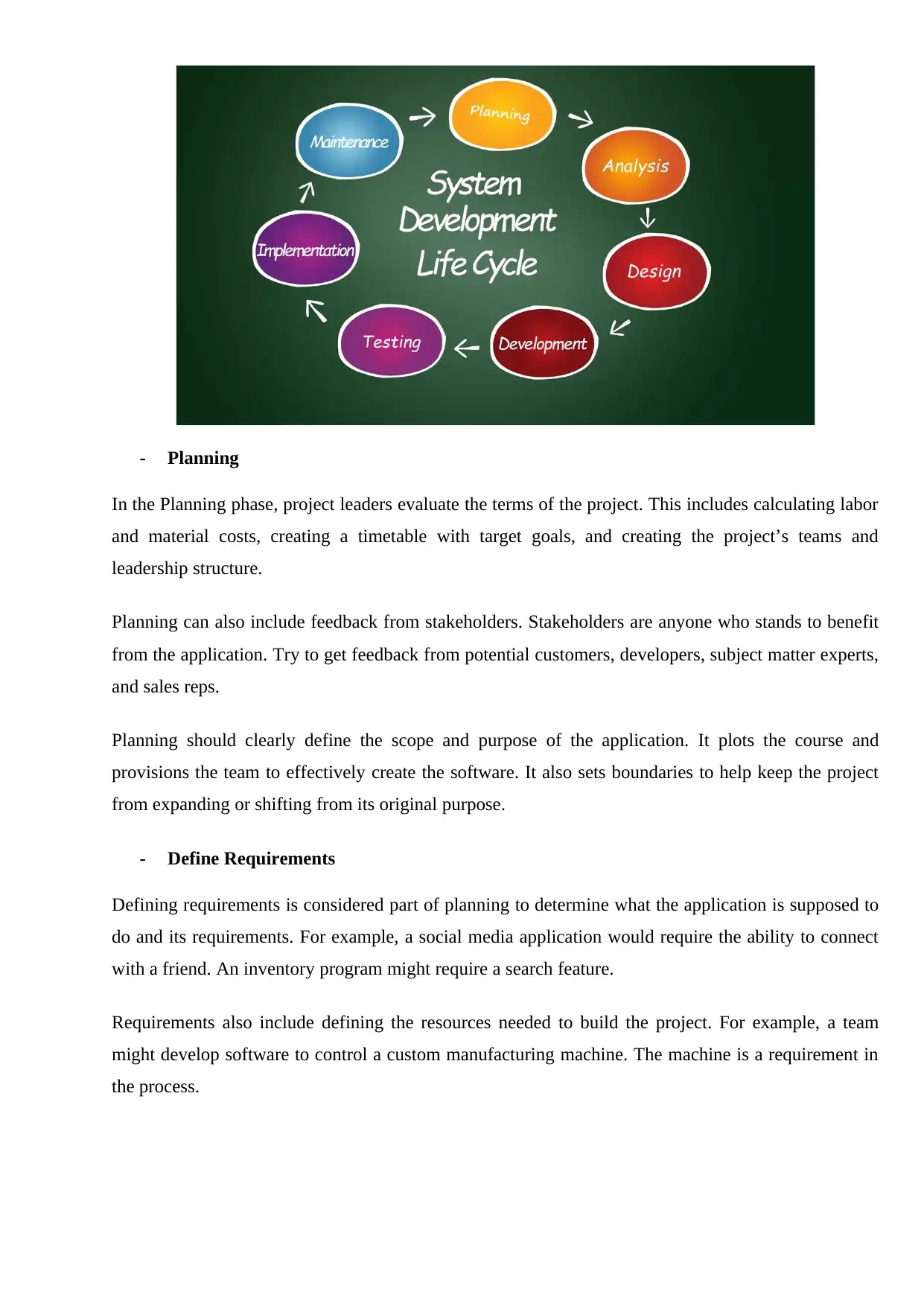
- Planning
In the Planning phase, project leaders evaluate the terms of the project. This includes calculating labor
and material costs, creating a timetable with target goals, and creating the project’s teams and
leadership structure.
Planning can also include feedback from stakeholders. Stakeholders are anyone who stands to benefit
from the application. Try to get feedback from potential customers, developers, subject matter experts,
and sales reps.
Planning should clearly define the scope and purpose of the application. It plots the course and
provisions the team to effectively create the software. It also sets boundaries to help keep the project
from expanding or shifting from its original purpose.
- Define Requirements
Defining requirements is considered part of planning to determine what the application is supposed to
do and its requirements. For example, a social media application would require the ability to connect
with a friend. An inventory program might require a search feature.
Requirements also include defining the resources needed to build the project. For example, a team
might develop software to control a custom manufacturing machine. The machine is a requirement in
the process.
In the Planning phase, project leaders evaluate the terms of the project. This includes calculating labor
and material costs, creating a timetable with target goals, and creating the project’s teams and
leadership structure.
Planning can also include feedback from stakeholders. Stakeholders are anyone who stands to benefit
from the application. Try to get feedback from potential customers, developers, subject matter experts,
and sales reps.
Planning should clearly define the scope and purpose of the application. It plots the course and
provisions the team to effectively create the software. It also sets boundaries to help keep the project
from expanding or shifting from its original purpose.
- Define Requirements
Defining requirements is considered part of planning to determine what the application is supposed to
do and its requirements. For example, a social media application would require the ability to connect
with a friend. An inventory program might require a search feature.
Requirements also include defining the resources needed to build the project. For example, a team
might develop software to control a custom manufacturing machine. The machine is a requirement in
the process.
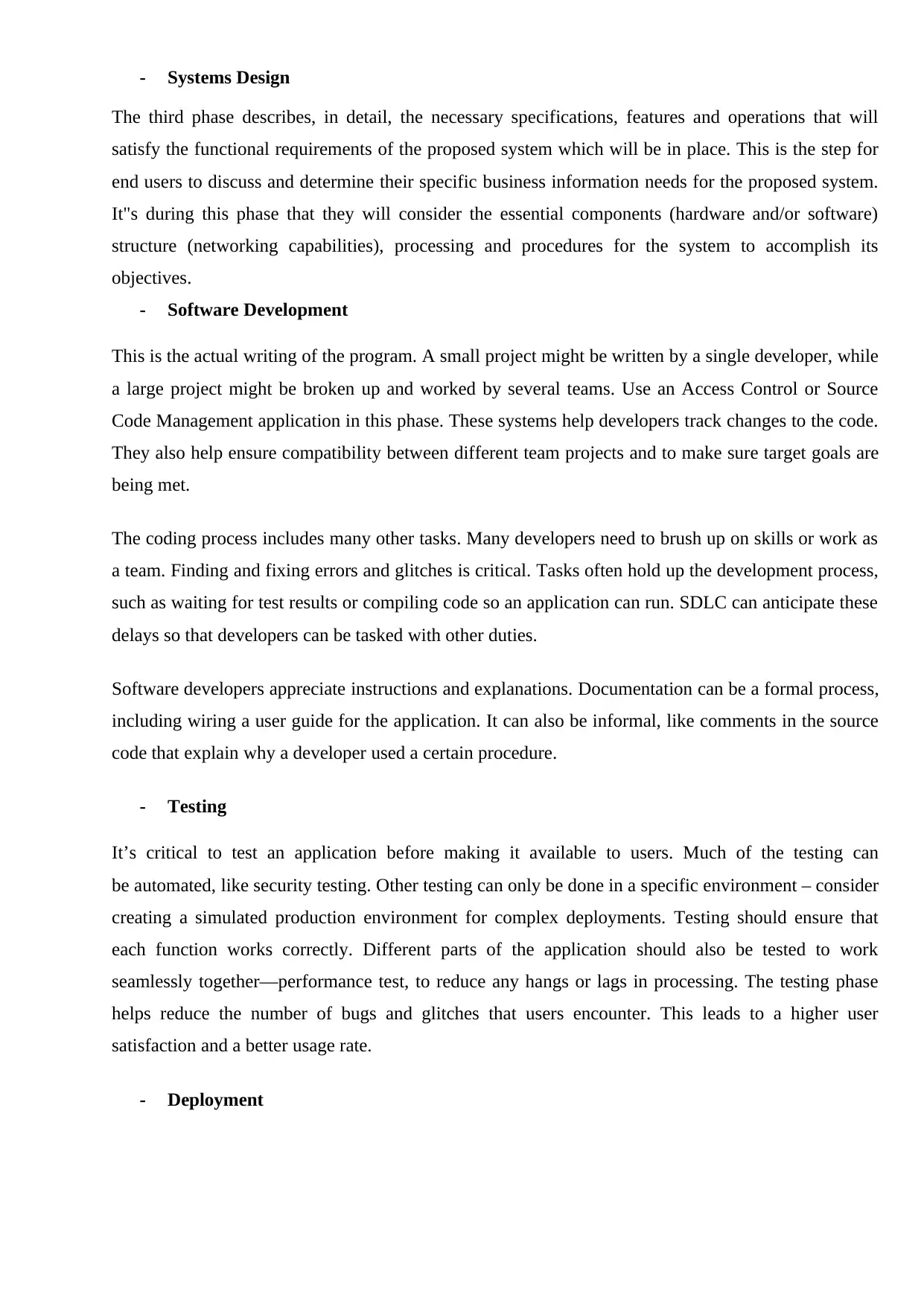
- Systems Design
The third phase describes, in detail, the necessary specifications, features and operations that will
satisfy the functional requirements of the proposed system which will be in place. This is the step for
end users to discuss and determine their specific business information needs for the proposed system.
It"s during this phase that they will consider the essential components (hardware and/or software)
structure (networking capabilities), processing and procedures for the system to accomplish its
objectives.
- Software Development
This is the actual writing of the program. A small project might be written by a single developer, while
a large project might be broken up and worked by several teams. Use an Access Control or Source
Code Management application in this phase. These systems help developers track changes to the code.
They also help ensure compatibility between different team projects and to make sure target goals are
being met.
The coding process includes many other tasks. Many developers need to brush up on skills or work as
a team. Finding and fixing errors and glitches is critical. Tasks often hold up the development process,
such as waiting for test results or compiling code so an application can run. SDLC can anticipate these
delays so that developers can be tasked with other duties.
Software developers appreciate instructions and explanations. Documentation can be a formal process,
including wiring a user guide for the application. It can also be informal, like comments in the source
code that explain why a developer used a certain procedure.
- Testing
It’s critical to test an application before making it available to users. Much of the testing can
be automated, like security testing. Other testing can only be done in a specific environment – consider
creating a simulated production environment for complex deployments. Testing should ensure that
each function works correctly. Different parts of the application should also be tested to work
seamlessly together—performance test, to reduce any hangs or lags in processing. The testing phase
helps reduce the number of bugs and glitches that users encounter. This leads to a higher user
satisfaction and a better usage rate.
- Deployment
The third phase describes, in detail, the necessary specifications, features and operations that will
satisfy the functional requirements of the proposed system which will be in place. This is the step for
end users to discuss and determine their specific business information needs for the proposed system.
It"s during this phase that they will consider the essential components (hardware and/or software)
structure (networking capabilities), processing and procedures for the system to accomplish its
objectives.
- Software Development
This is the actual writing of the program. A small project might be written by a single developer, while
a large project might be broken up and worked by several teams. Use an Access Control or Source
Code Management application in this phase. These systems help developers track changes to the code.
They also help ensure compatibility between different team projects and to make sure target goals are
being met.
The coding process includes many other tasks. Many developers need to brush up on skills or work as
a team. Finding and fixing errors and glitches is critical. Tasks often hold up the development process,
such as waiting for test results or compiling code so an application can run. SDLC can anticipate these
delays so that developers can be tasked with other duties.
Software developers appreciate instructions and explanations. Documentation can be a formal process,
including wiring a user guide for the application. It can also be informal, like comments in the source
code that explain why a developer used a certain procedure.
- Testing
It’s critical to test an application before making it available to users. Much of the testing can
be automated, like security testing. Other testing can only be done in a specific environment – consider
creating a simulated production environment for complex deployments. Testing should ensure that
each function works correctly. Different parts of the application should also be tested to work
seamlessly together—performance test, to reduce any hangs or lags in processing. The testing phase
helps reduce the number of bugs and glitches that users encounter. This leads to a higher user
satisfaction and a better usage rate.
- Deployment
⊘ This is a preview!⊘
Do you want full access?
Subscribe today to unlock all pages.

Trusted by 1+ million students worldwide
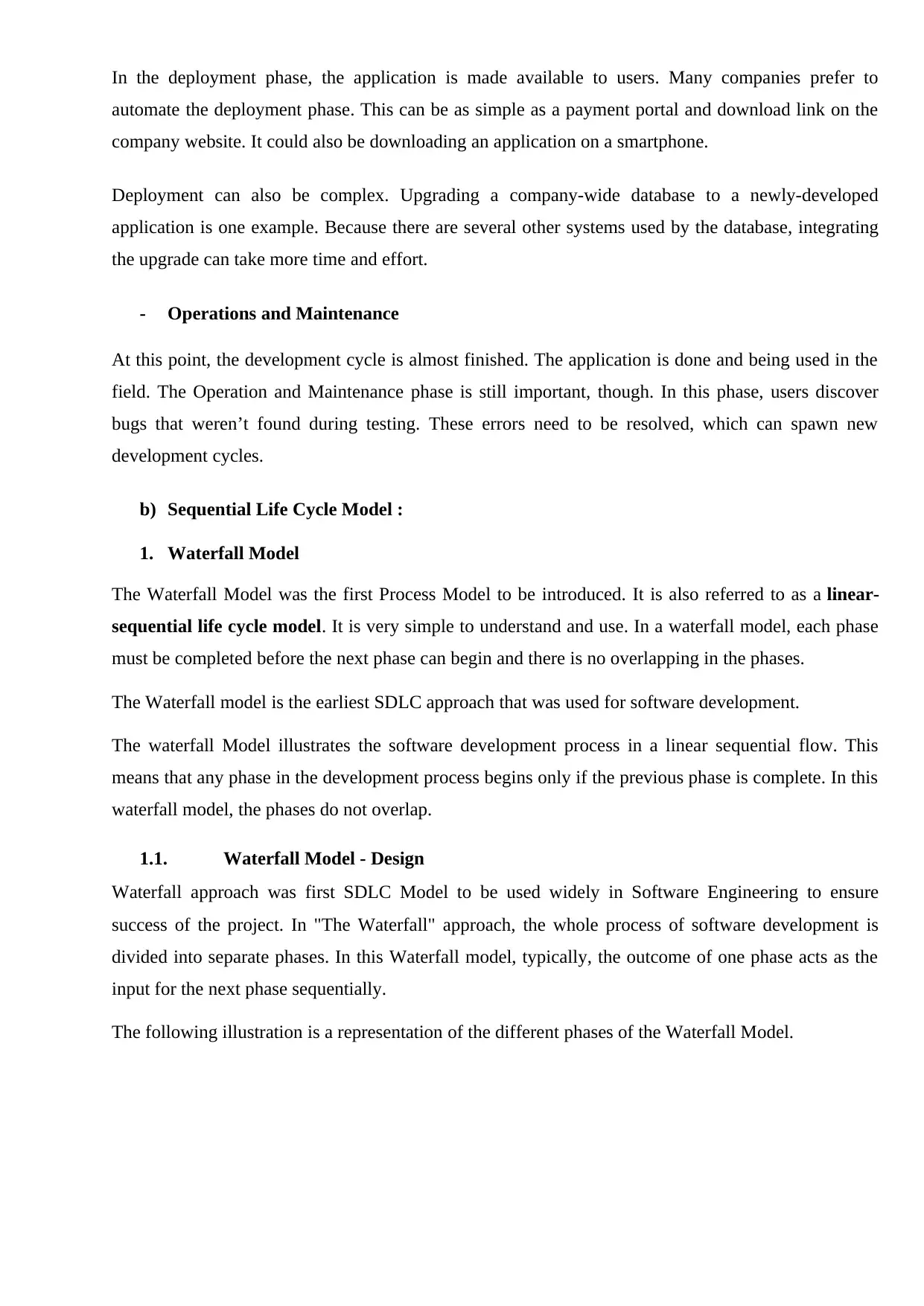
In the deployment phase, the application is made available to users. Many companies prefer to
automate the deployment phase. This can be as simple as a payment portal and download link on the
company website. It could also be downloading an application on a smartphone.
Deployment can also be complex. Upgrading a company-wide database to a newly-developed
application is one example. Because there are several other systems used by the database, integrating
the upgrade can take more time and effort.
- Operations and Maintenance
At this point, the development cycle is almost finished. The application is done and being used in the
field. The Operation and Maintenance phase is still important, though. In this phase, users discover
bugs that weren’t found during testing. These errors need to be resolved, which can spawn new
development cycles.
b) Sequential Life Cycle Model :
1. Waterfall Model
The Waterfall Model was the first Process Model to be introduced. It is also referred to as a linear-
sequential life cycle model. It is very simple to understand and use. In a waterfall model, each phase
must be completed before the next phase can begin and there is no overlapping in the phases.
The Waterfall model is the earliest SDLC approach that was used for software development.
The waterfall Model illustrates the software development process in a linear sequential flow. This
means that any phase in the development process begins only if the previous phase is complete. In this
waterfall model, the phases do not overlap.
1.1. Waterfall Model - Design
Waterfall approach was first SDLC Model to be used widely in Software Engineering to ensure
success of the project. In "The Waterfall" approach, the whole process of software development is
divided into separate phases. In this Waterfall model, typically, the outcome of one phase acts as the
input for the next phase sequentially.
The following illustration is a representation of the different phases of the Waterfall Model.
automate the deployment phase. This can be as simple as a payment portal and download link on the
company website. It could also be downloading an application on a smartphone.
Deployment can also be complex. Upgrading a company-wide database to a newly-developed
application is one example. Because there are several other systems used by the database, integrating
the upgrade can take more time and effort.
- Operations and Maintenance
At this point, the development cycle is almost finished. The application is done and being used in the
field. The Operation and Maintenance phase is still important, though. In this phase, users discover
bugs that weren’t found during testing. These errors need to be resolved, which can spawn new
development cycles.
b) Sequential Life Cycle Model :
1. Waterfall Model
The Waterfall Model was the first Process Model to be introduced. It is also referred to as a linear-
sequential life cycle model. It is very simple to understand and use. In a waterfall model, each phase
must be completed before the next phase can begin and there is no overlapping in the phases.
The Waterfall model is the earliest SDLC approach that was used for software development.
The waterfall Model illustrates the software development process in a linear sequential flow. This
means that any phase in the development process begins only if the previous phase is complete. In this
waterfall model, the phases do not overlap.
1.1. Waterfall Model - Design
Waterfall approach was first SDLC Model to be used widely in Software Engineering to ensure
success of the project. In "The Waterfall" approach, the whole process of software development is
divided into separate phases. In this Waterfall model, typically, the outcome of one phase acts as the
input for the next phase sequentially.
The following illustration is a representation of the different phases of the Waterfall Model.
Paraphrase This Document
Need a fresh take? Get an instant paraphrase of this document with our AI Paraphraser
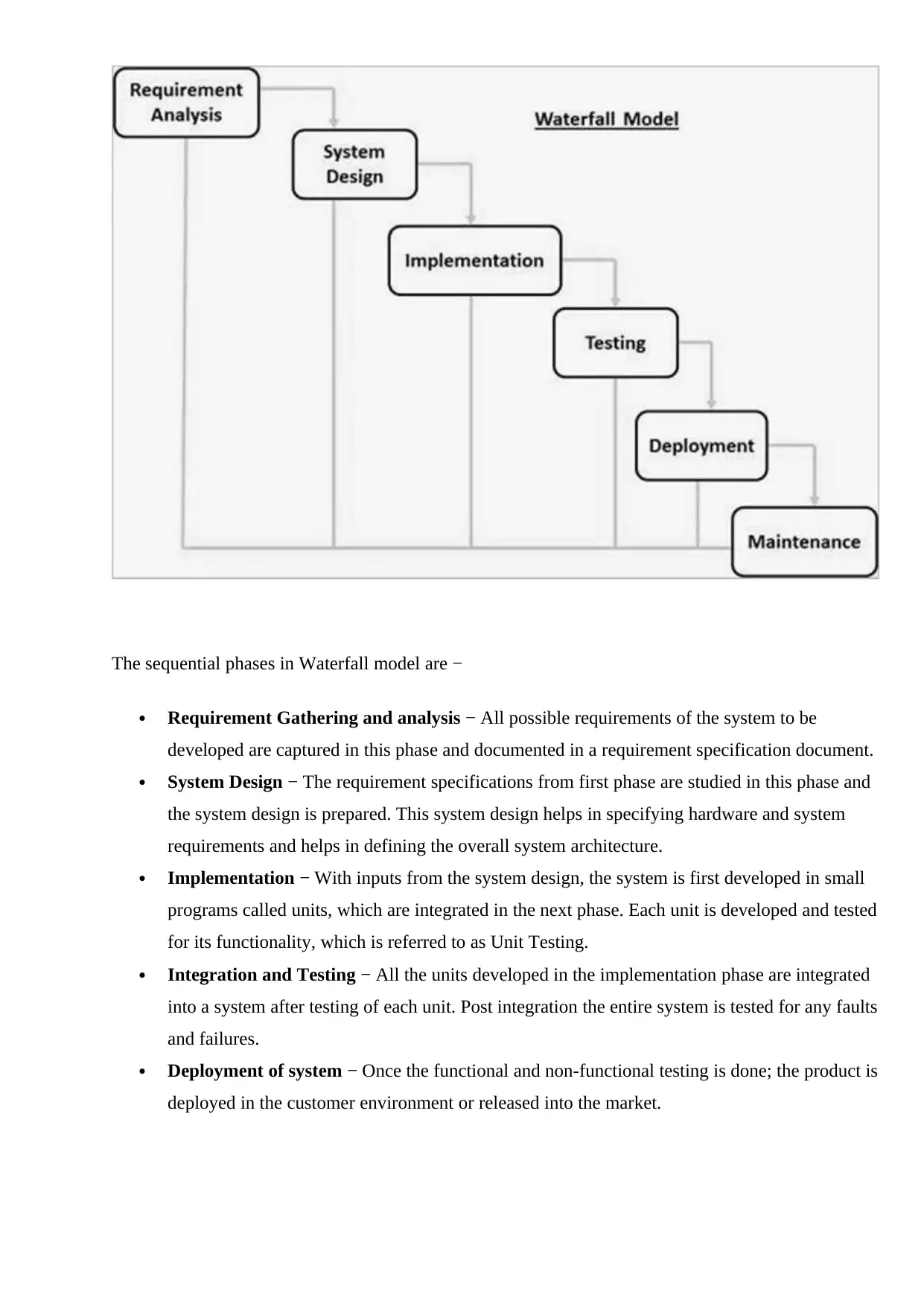
The sequential phases in Waterfall model are −
Requirement Gathering and analysis − All possible requirements of the system to be
developed are captured in this phase and documented in a requirement specification document.
System Design − The requirement specifications from first phase are studied in this phase and
the system design is prepared. This system design helps in specifying hardware and system
requirements and helps in defining the overall system architecture.
Implementation − With inputs from the system design, the system is first developed in small
programs called units, which are integrated in the next phase. Each unit is developed and tested
for its functionality, which is referred to as Unit Testing.
Integration and Testing − All the units developed in the implementation phase are integrated
into a system after testing of each unit. Post integration the entire system is tested for any faults
and failures.
Deployment of system − Once the functional and non-functional testing is done; the product is
deployed in the customer environment or released into the market.
Requirement Gathering and analysis − All possible requirements of the system to be
developed are captured in this phase and documented in a requirement specification document.
System Design − The requirement specifications from first phase are studied in this phase and
the system design is prepared. This system design helps in specifying hardware and system
requirements and helps in defining the overall system architecture.
Implementation − With inputs from the system design, the system is first developed in small
programs called units, which are integrated in the next phase. Each unit is developed and tested
for its functionality, which is referred to as Unit Testing.
Integration and Testing − All the units developed in the implementation phase are integrated
into a system after testing of each unit. Post integration the entire system is tested for any faults
and failures.
Deployment of system − Once the functional and non-functional testing is done; the product is
deployed in the customer environment or released into the market.
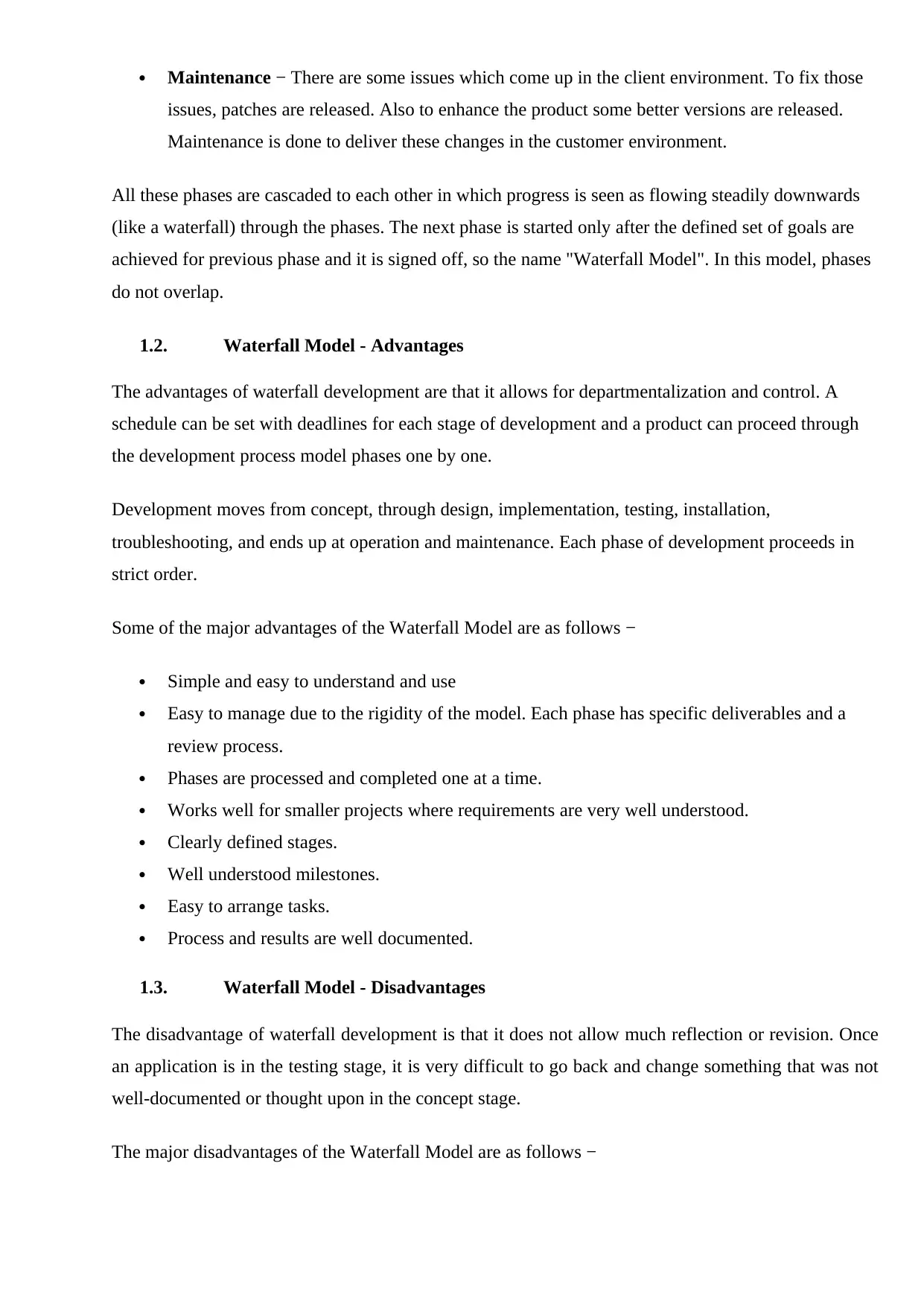
Maintenance − There are some issues which come up in the client environment. To fix those
issues, patches are released. Also to enhance the product some better versions are released.
Maintenance is done to deliver these changes in the customer environment.
All these phases are cascaded to each other in which progress is seen as flowing steadily downwards
(like a waterfall) through the phases. The next phase is started only after the defined set of goals are
achieved for previous phase and it is signed off, so the name "Waterfall Model". In this model, phases
do not overlap.
1.2. Waterfall Model - Advantages
The advantages of waterfall development are that it allows for departmentalization and control. A
schedule can be set with deadlines for each stage of development and a product can proceed through
the development process model phases one by one.
Development moves from concept, through design, implementation, testing, installation,
troubleshooting, and ends up at operation and maintenance. Each phase of development proceeds in
strict order.
Some of the major advantages of the Waterfall Model are as follows −
Simple and easy to understand and use
Easy to manage due to the rigidity of the model. Each phase has specific deliverables and a
review process.
Phases are processed and completed one at a time.
Works well for smaller projects where requirements are very well understood.
Clearly defined stages.
Well understood milestones.
Easy to arrange tasks.
Process and results are well documented.
1.3. Waterfall Model - Disadvantages
The disadvantage of waterfall development is that it does not allow much reflection or revision. Once
an application is in the testing stage, it is very difficult to go back and change something that was not
well-documented or thought upon in the concept stage.
The major disadvantages of the Waterfall Model are as follows −
issues, patches are released. Also to enhance the product some better versions are released.
Maintenance is done to deliver these changes in the customer environment.
All these phases are cascaded to each other in which progress is seen as flowing steadily downwards
(like a waterfall) through the phases. The next phase is started only after the defined set of goals are
achieved for previous phase and it is signed off, so the name "Waterfall Model". In this model, phases
do not overlap.
1.2. Waterfall Model - Advantages
The advantages of waterfall development are that it allows for departmentalization and control. A
schedule can be set with deadlines for each stage of development and a product can proceed through
the development process model phases one by one.
Development moves from concept, through design, implementation, testing, installation,
troubleshooting, and ends up at operation and maintenance. Each phase of development proceeds in
strict order.
Some of the major advantages of the Waterfall Model are as follows −
Simple and easy to understand and use
Easy to manage due to the rigidity of the model. Each phase has specific deliverables and a
review process.
Phases are processed and completed one at a time.
Works well for smaller projects where requirements are very well understood.
Clearly defined stages.
Well understood milestones.
Easy to arrange tasks.
Process and results are well documented.
1.3. Waterfall Model - Disadvantages
The disadvantage of waterfall development is that it does not allow much reflection or revision. Once
an application is in the testing stage, it is very difficult to go back and change something that was not
well-documented or thought upon in the concept stage.
The major disadvantages of the Waterfall Model are as follows −
⊘ This is a preview!⊘
Do you want full access?
Subscribe today to unlock all pages.

Trusted by 1+ million students worldwide
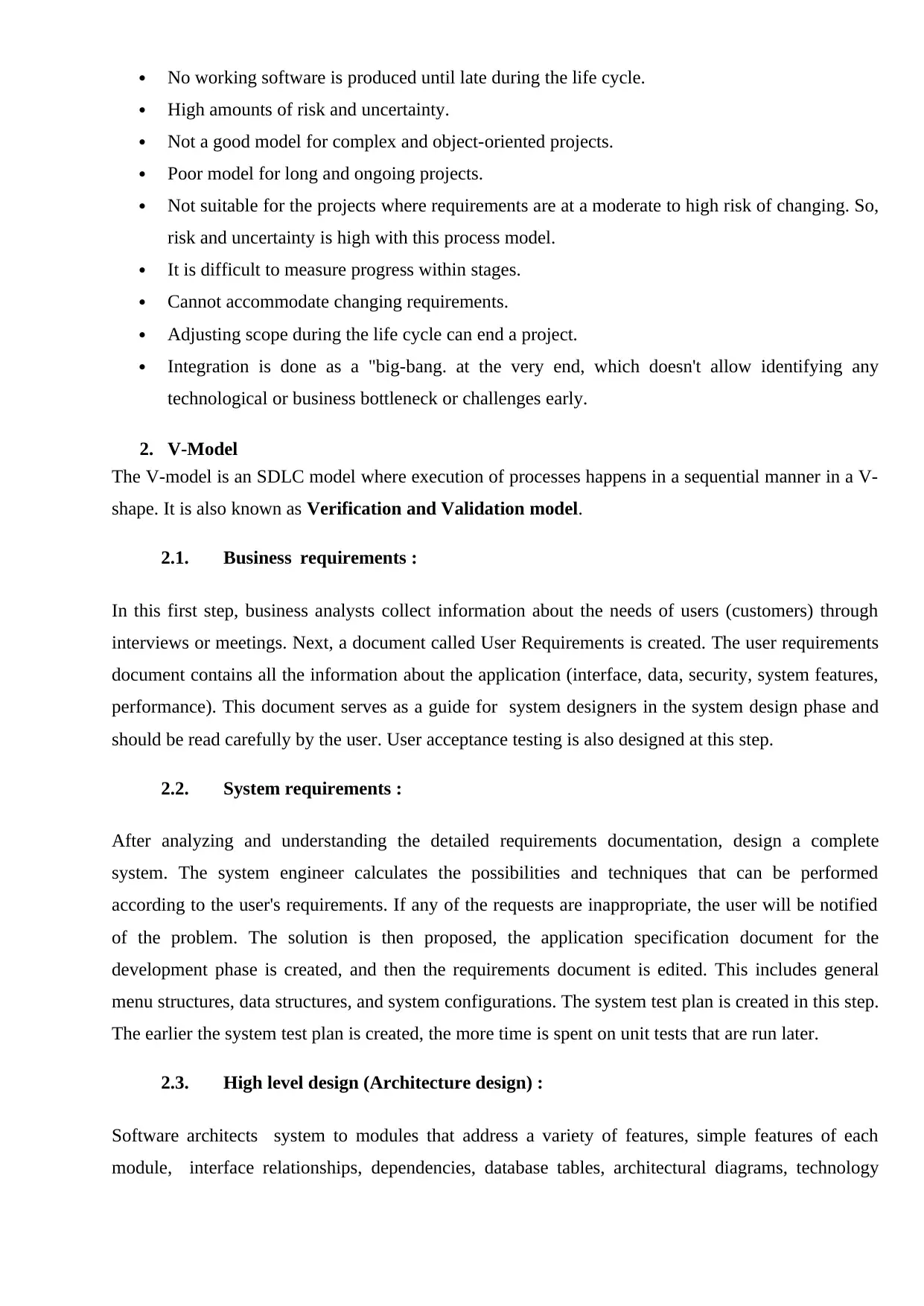
No working software is produced until late during the life cycle.
High amounts of risk and uncertainty.
Not a good model for complex and object-oriented projects.
Poor model for long and ongoing projects.
Not suitable for the projects where requirements are at a moderate to high risk of changing. So,
risk and uncertainty is high with this process model.
It is difficult to measure progress within stages.
Cannot accommodate changing requirements.
Adjusting scope during the life cycle can end a project.
Integration is done as a "big-bang. at the very end, which doesn't allow identifying any
technological or business bottleneck or challenges early.
2. V-Model
The V-model is an SDLC model where execution of processes happens in a sequential manner in a V-
shape. It is also known as Verification and Validation model.
2.1. Business requirements :
In this first step, business analysts collect information about the needs of users (customers) through
interviews or meetings. Next, a document called User Requirements is created. The user requirements
document contains all the information about the application (interface, data, security, system features,
performance). This document serves as a guide for system designers in the system design phase and
should be read carefully by the user. User acceptance testing is also designed at this step.
2.2. System requirements :
After analyzing and understanding the detailed requirements documentation, design a complete
system. The system engineer calculates the possibilities and techniques that can be performed
according to the user's requirements. If any of the requests are inappropriate, the user will be notified
of the problem. The solution is then proposed, the application specification document for the
development phase is created, and then the requirements document is edited. This includes general
menu structures, data structures, and system configurations. The system test plan is created in this step.
The earlier the system test plan is created, the more time is spent on unit tests that are run later.
2.3. High level design (Architecture design) :
Software architects system to modules that address a variety of features, simple features of each
module, interface relationships, dependencies, database tables, architectural diagrams, technology
High amounts of risk and uncertainty.
Not a good model for complex and object-oriented projects.
Poor model for long and ongoing projects.
Not suitable for the projects where requirements are at a moderate to high risk of changing. So,
risk and uncertainty is high with this process model.
It is difficult to measure progress within stages.
Cannot accommodate changing requirements.
Adjusting scope during the life cycle can end a project.
Integration is done as a "big-bang. at the very end, which doesn't allow identifying any
technological or business bottleneck or challenges early.
2. V-Model
The V-model is an SDLC model where execution of processes happens in a sequential manner in a V-
shape. It is also known as Verification and Validation model.
2.1. Business requirements :
In this first step, business analysts collect information about the needs of users (customers) through
interviews or meetings. Next, a document called User Requirements is created. The user requirements
document contains all the information about the application (interface, data, security, system features,
performance). This document serves as a guide for system designers in the system design phase and
should be read carefully by the user. User acceptance testing is also designed at this step.
2.2. System requirements :
After analyzing and understanding the detailed requirements documentation, design a complete
system. The system engineer calculates the possibilities and techniques that can be performed
according to the user's requirements. If any of the requests are inappropriate, the user will be notified
of the problem. The solution is then proposed, the application specification document for the
development phase is created, and then the requirements document is edited. This includes general
menu structures, data structures, and system configurations. The system test plan is created in this step.
The earlier the system test plan is created, the more time is spent on unit tests that are run later.
2.3. High level design (Architecture design) :
Software architects system to modules that address a variety of features, simple features of each
module, interface relationships, dependencies, database tables, architectural diagrams, technology
Paraphrase This Document
Need a fresh take? Get an instant paraphrase of this document with our AI Paraphraser
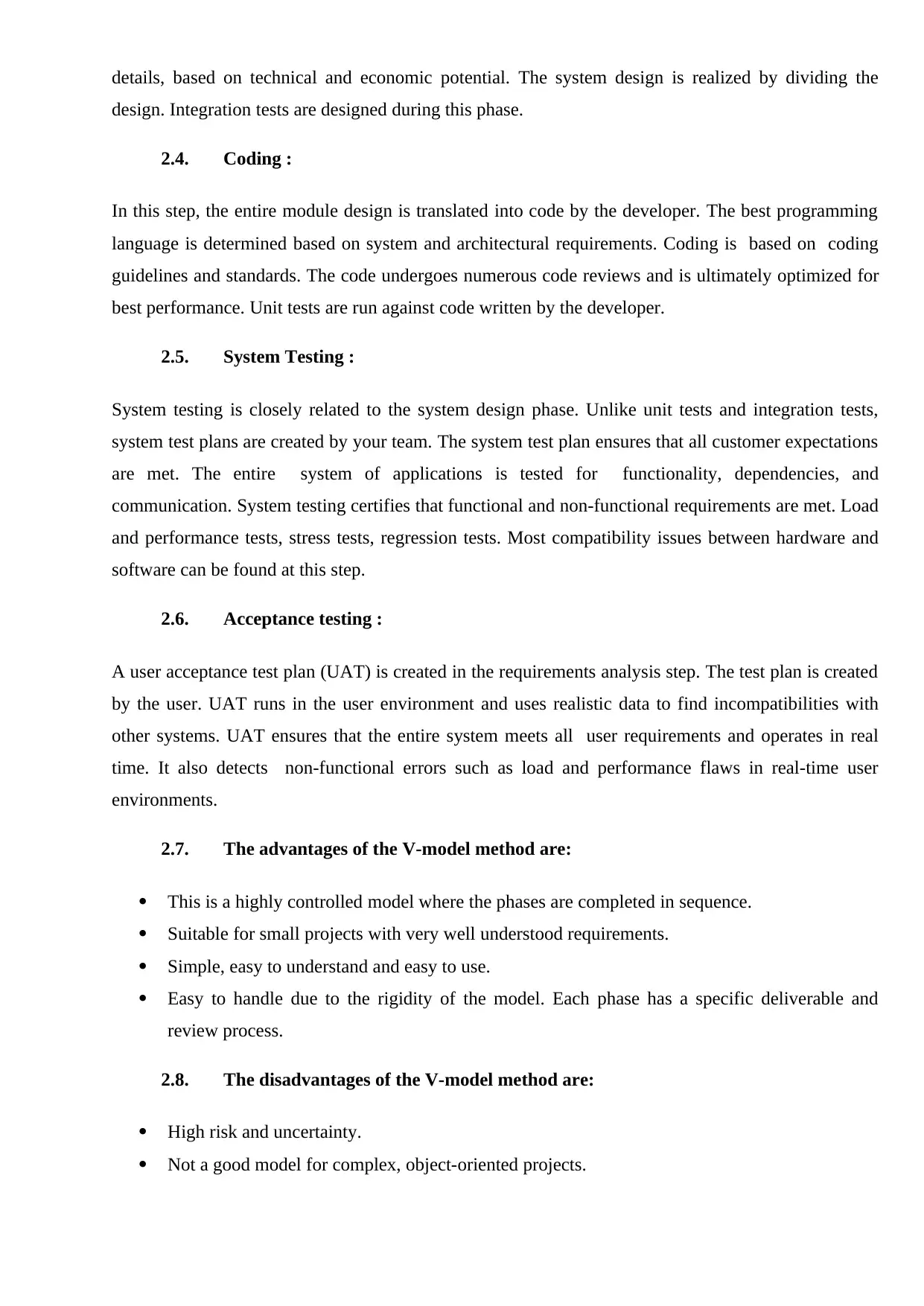
details, based on technical and economic potential. The system design is realized by dividing the
design. Integration tests are designed during this phase.
2.4. Coding :
In this step, the entire module design is translated into code by the developer. The best programming
language is determined based on system and architectural requirements. Coding is based on coding
guidelines and standards. The code undergoes numerous code reviews and is ultimately optimized for
best performance. Unit tests are run against code written by the developer.
2.5. System Testing :
System testing is closely related to the system design phase. Unlike unit tests and integration tests,
system test plans are created by your team. The system test plan ensures that all customer expectations
are met. The entire system of applications is tested for functionality, dependencies, and
communication. System testing certifies that functional and non-functional requirements are met. Load
and performance tests, stress tests, regression tests. Most compatibility issues between hardware and
software can be found at this step.
2.6. Acceptance testing :
A user acceptance test plan (UAT) is created in the requirements analysis step. The test plan is created
by the user. UAT runs in the user environment and uses realistic data to find incompatibilities with
other systems. UAT ensures that the entire system meets all user requirements and operates in real
time. It also detects non-functional errors such as load and performance flaws in real-time user
environments.
2.7. The advantages of the V-model method are:
This is a highly controlled model where the phases are completed in sequence.
Suitable for small projects with very well understood requirements.
Simple, easy to understand and easy to use.
Easy to handle due to the rigidity of the model. Each phase has a specific deliverable and
review process.
2.8. The disadvantages of the V-model method are:
High risk and uncertainty.
Not a good model for complex, object-oriented projects.
design. Integration tests are designed during this phase.
2.4. Coding :
In this step, the entire module design is translated into code by the developer. The best programming
language is determined based on system and architectural requirements. Coding is based on coding
guidelines and standards. The code undergoes numerous code reviews and is ultimately optimized for
best performance. Unit tests are run against code written by the developer.
2.5. System Testing :
System testing is closely related to the system design phase. Unlike unit tests and integration tests,
system test plans are created by your team. The system test plan ensures that all customer expectations
are met. The entire system of applications is tested for functionality, dependencies, and
communication. System testing certifies that functional and non-functional requirements are met. Load
and performance tests, stress tests, regression tests. Most compatibility issues between hardware and
software can be found at this step.
2.6. Acceptance testing :
A user acceptance test plan (UAT) is created in the requirements analysis step. The test plan is created
by the user. UAT runs in the user environment and uses realistic data to find incompatibilities with
other systems. UAT ensures that the entire system meets all user requirements and operates in real
time. It also detects non-functional errors such as load and performance flaws in real-time user
environments.
2.7. The advantages of the V-model method are:
This is a highly controlled model where the phases are completed in sequence.
Suitable for small projects with very well understood requirements.
Simple, easy to understand and easy to use.
Easy to handle due to the rigidity of the model. Each phase has a specific deliverable and
review process.
2.8. The disadvantages of the V-model method are:
High risk and uncertainty.
Not a good model for complex, object-oriented projects.
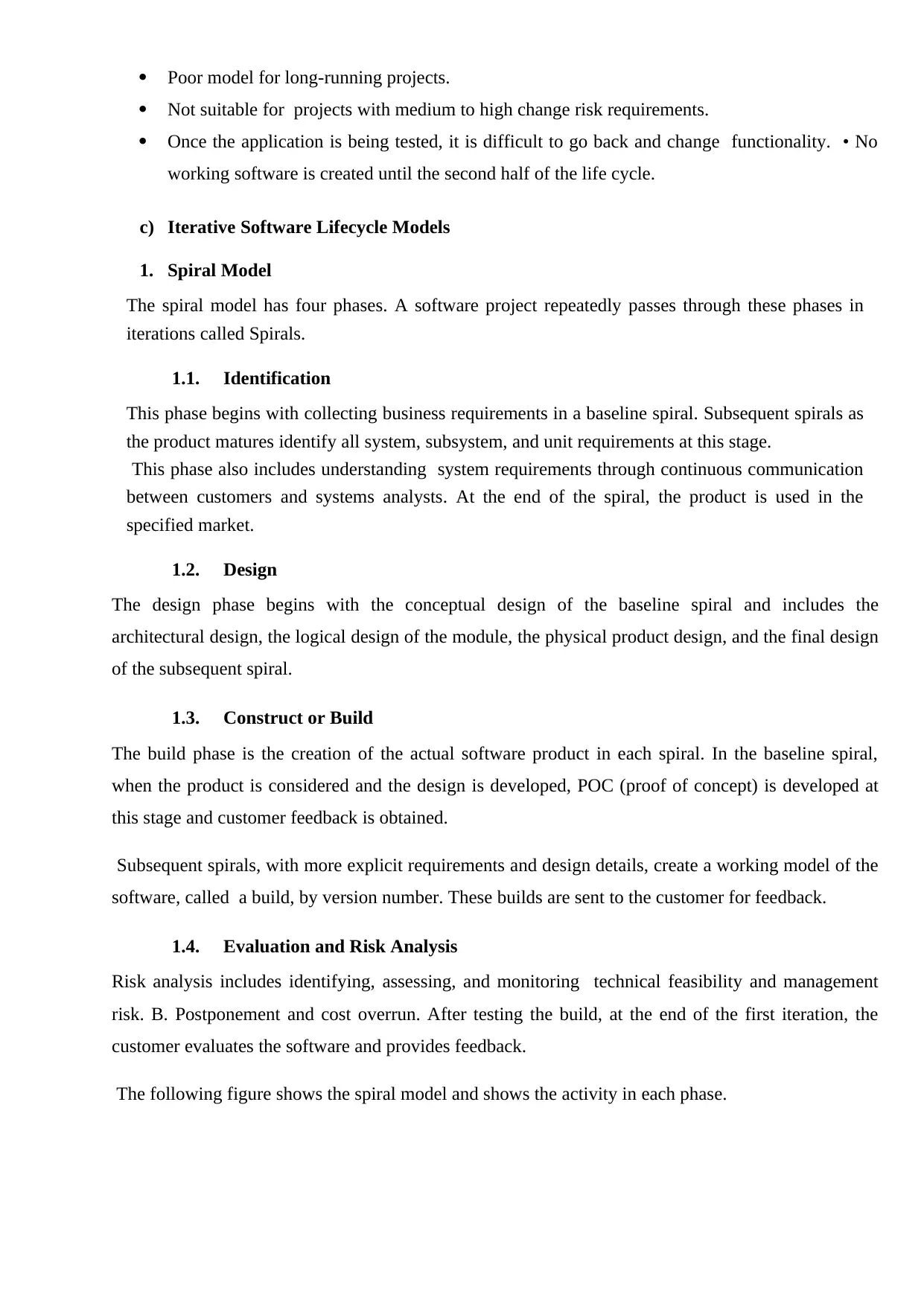
Poor model for long-running projects.
Not suitable for projects with medium to high change risk requirements.
Once the application is being tested, it is difficult to go back and change functionality. • No
working software is created until the second half of the life cycle.
c) Iterative Software Lifecycle Models
1. Spiral Model
The spiral model has four phases. A software project repeatedly passes through these phases in
iterations called Spirals.
1.1. Identification
This phase begins with collecting business requirements in a baseline spiral. Subsequent spirals as
the product matures identify all system, subsystem, and unit requirements at this stage.
This phase also includes understanding system requirements through continuous communication
between customers and systems analysts. At the end of the spiral, the product is used in the
specified market.
1.2. Design
The design phase begins with the conceptual design of the baseline spiral and includes the
architectural design, the logical design of the module, the physical product design, and the final design
of the subsequent spiral.
1.3. Construct or Build
The build phase is the creation of the actual software product in each spiral. In the baseline spiral,
when the product is considered and the design is developed, POC (proof of concept) is developed at
this stage and customer feedback is obtained.
Subsequent spirals, with more explicit requirements and design details, create a working model of the
software, called a build, by version number. These builds are sent to the customer for feedback.
1.4. Evaluation and Risk Analysis
Risk analysis includes identifying, assessing, and monitoring technical feasibility and management
risk. B. Postponement and cost overrun. After testing the build, at the end of the first iteration, the
customer evaluates the software and provides feedback.
The following figure shows the spiral model and shows the activity in each phase.
Not suitable for projects with medium to high change risk requirements.
Once the application is being tested, it is difficult to go back and change functionality. • No
working software is created until the second half of the life cycle.
c) Iterative Software Lifecycle Models
1. Spiral Model
The spiral model has four phases. A software project repeatedly passes through these phases in
iterations called Spirals.
1.1. Identification
This phase begins with collecting business requirements in a baseline spiral. Subsequent spirals as
the product matures identify all system, subsystem, and unit requirements at this stage.
This phase also includes understanding system requirements through continuous communication
between customers and systems analysts. At the end of the spiral, the product is used in the
specified market.
1.2. Design
The design phase begins with the conceptual design of the baseline spiral and includes the
architectural design, the logical design of the module, the physical product design, and the final design
of the subsequent spiral.
1.3. Construct or Build
The build phase is the creation of the actual software product in each spiral. In the baseline spiral,
when the product is considered and the design is developed, POC (proof of concept) is developed at
this stage and customer feedback is obtained.
Subsequent spirals, with more explicit requirements and design details, create a working model of the
software, called a build, by version number. These builds are sent to the customer for feedback.
1.4. Evaluation and Risk Analysis
Risk analysis includes identifying, assessing, and monitoring technical feasibility and management
risk. B. Postponement and cost overrun. After testing the build, at the end of the first iteration, the
customer evaluates the software and provides feedback.
The following figure shows the spiral model and shows the activity in each phase.
⊘ This is a preview!⊘
Do you want full access?
Subscribe today to unlock all pages.

Trusted by 1+ million students worldwide
1 out of 18
Related Documents
Your All-in-One AI-Powered Toolkit for Academic Success.
+13062052269
info@desklib.com
Available 24*7 on WhatsApp / Email
![[object Object]](/_next/static/media/star-bottom.7253800d.svg)
Unlock your academic potential
Copyright © 2020–2025 A2Z Services. All Rights Reserved. Developed and managed by ZUCOL.





